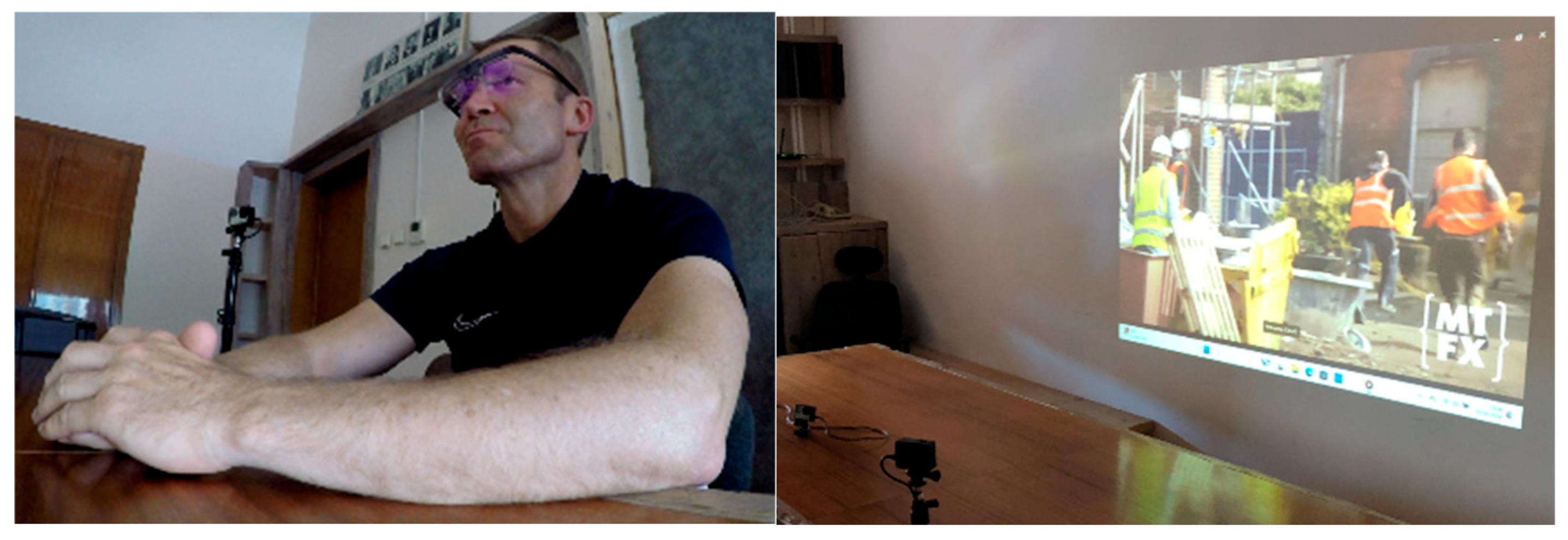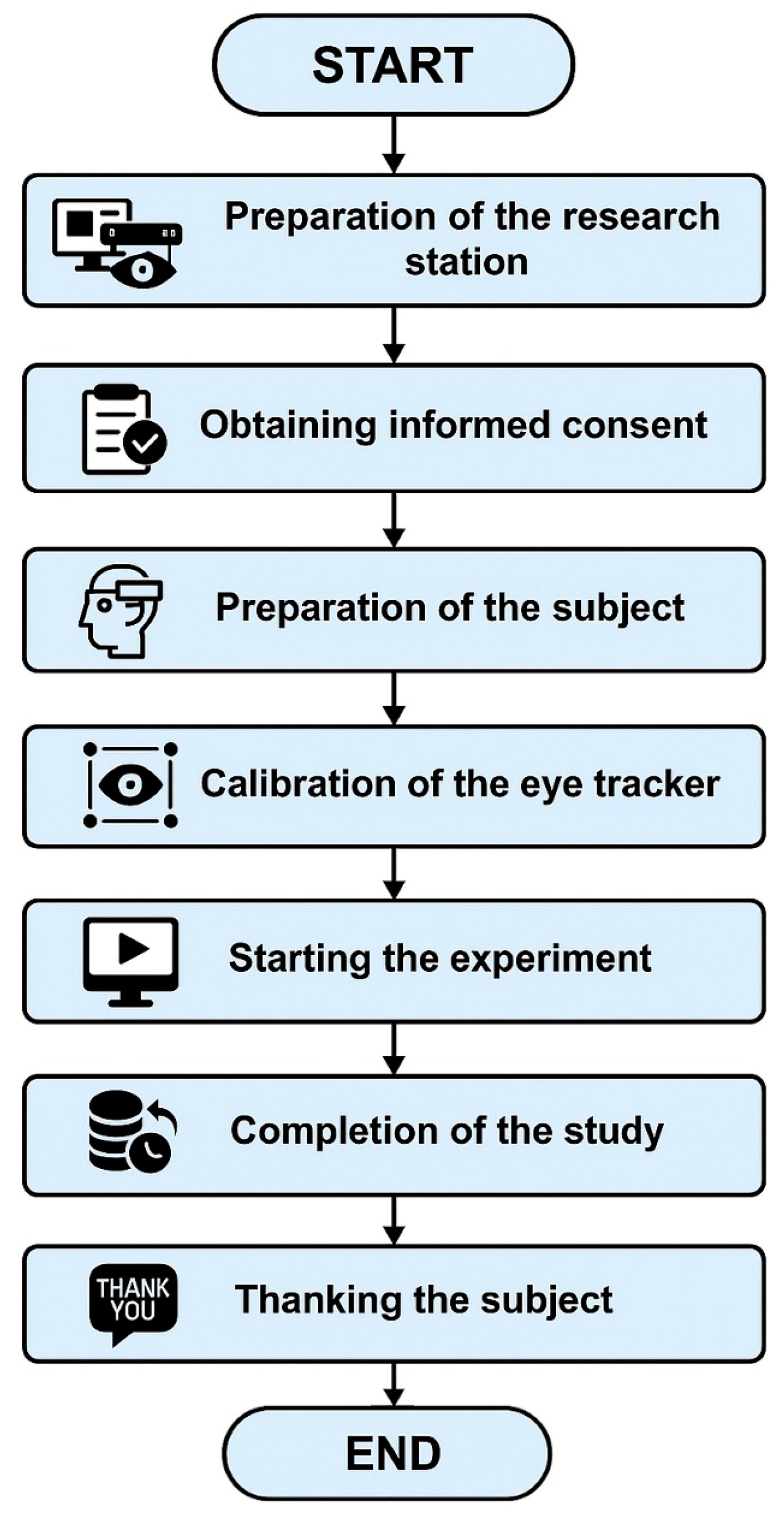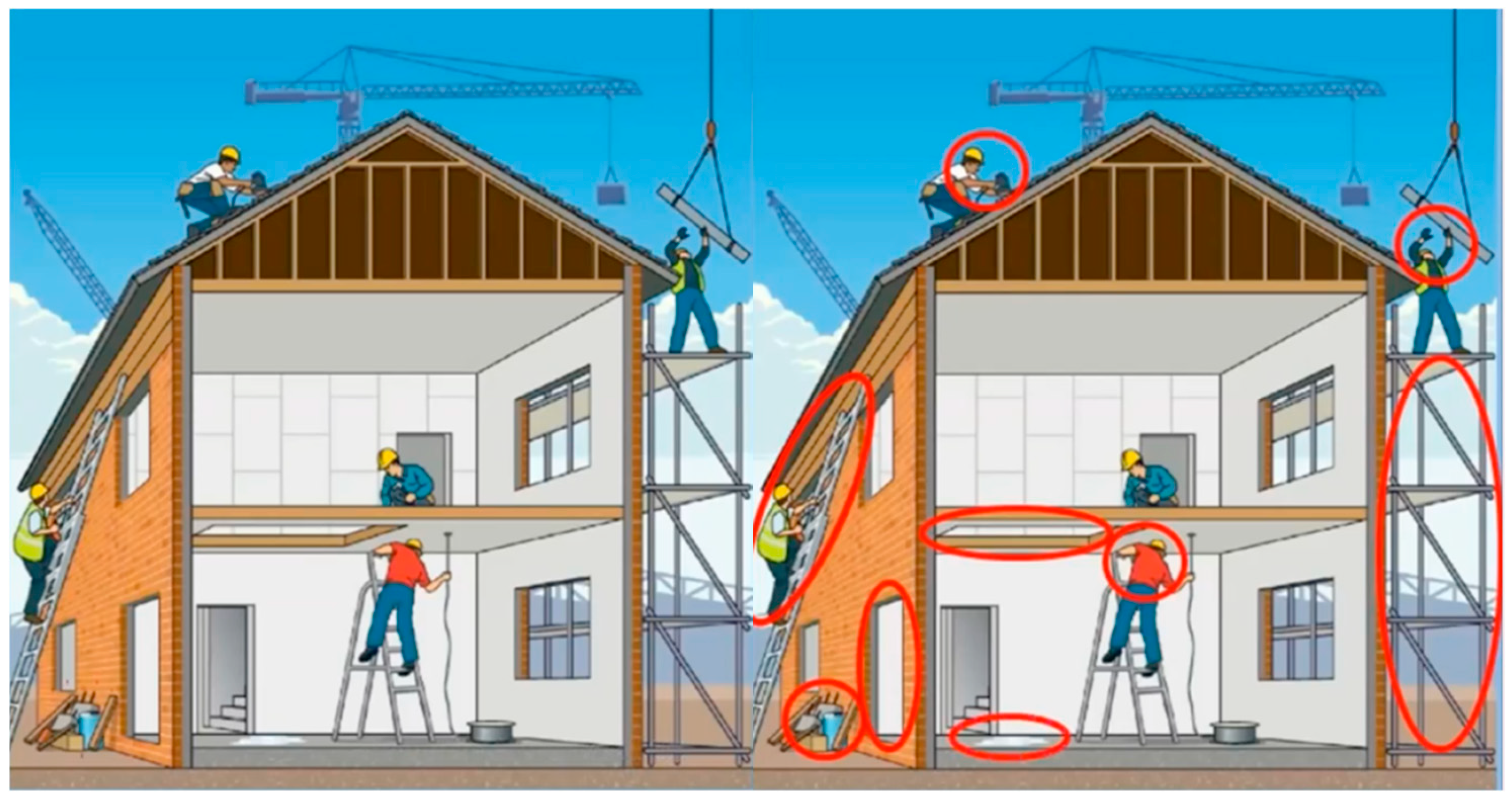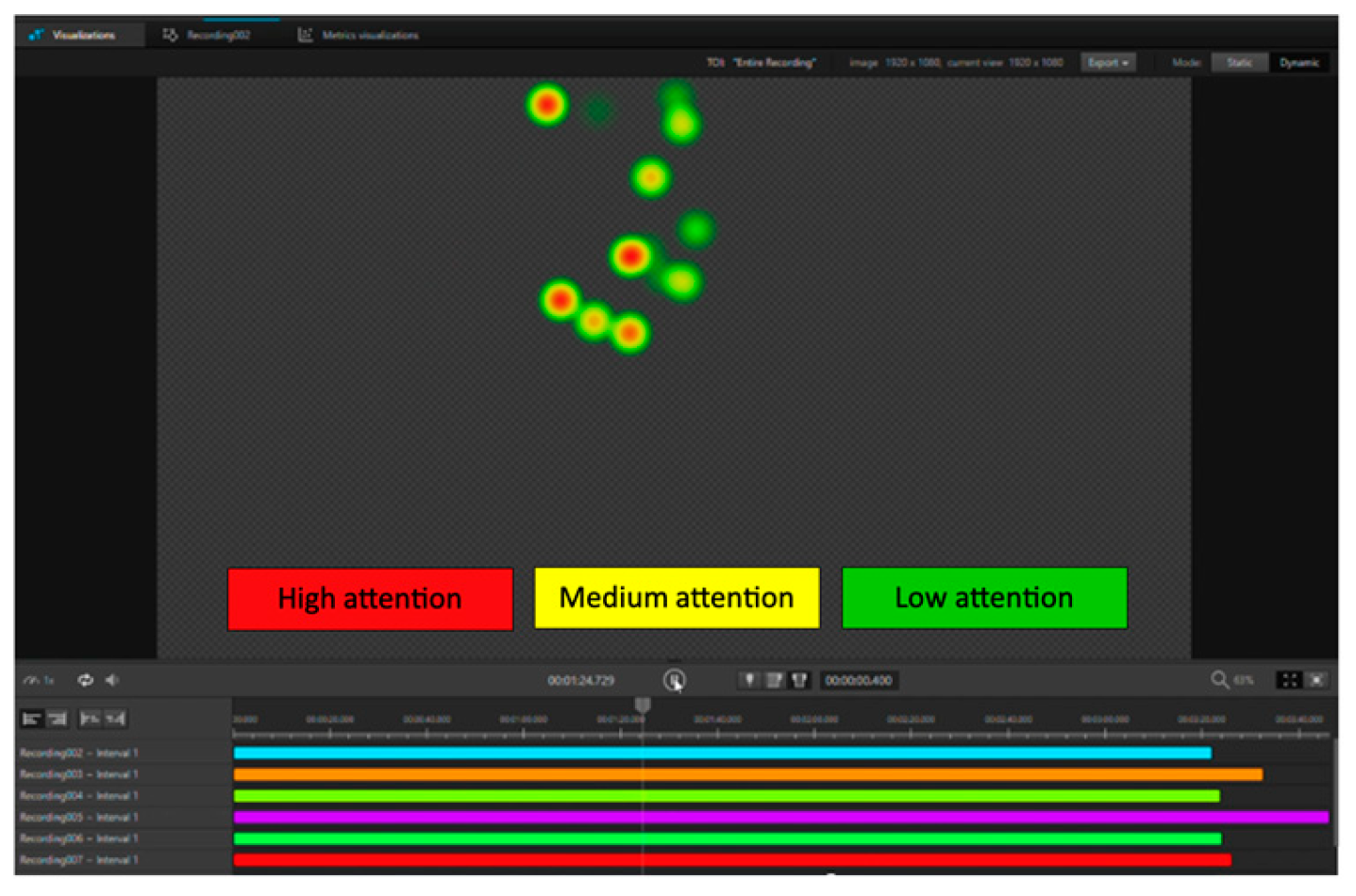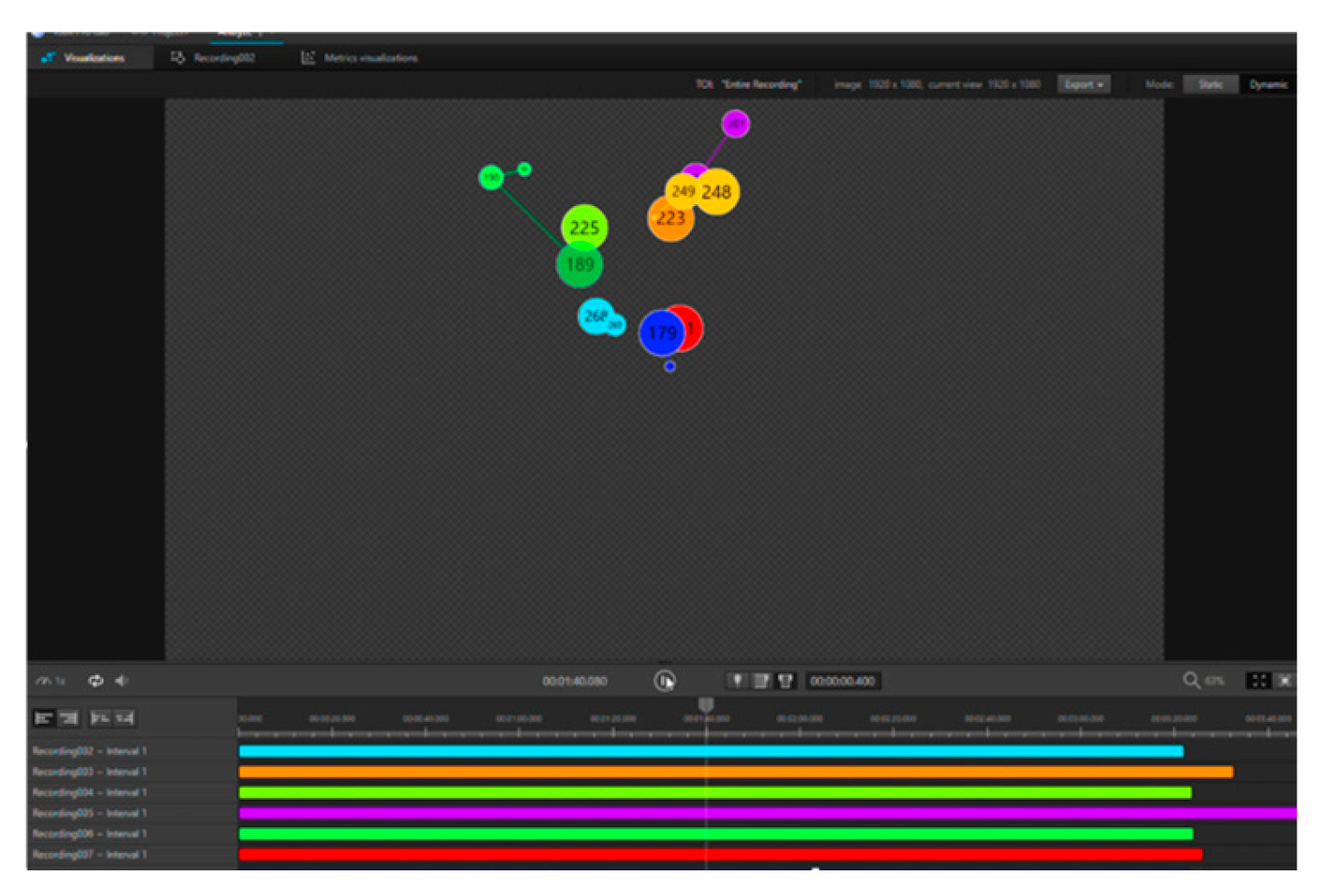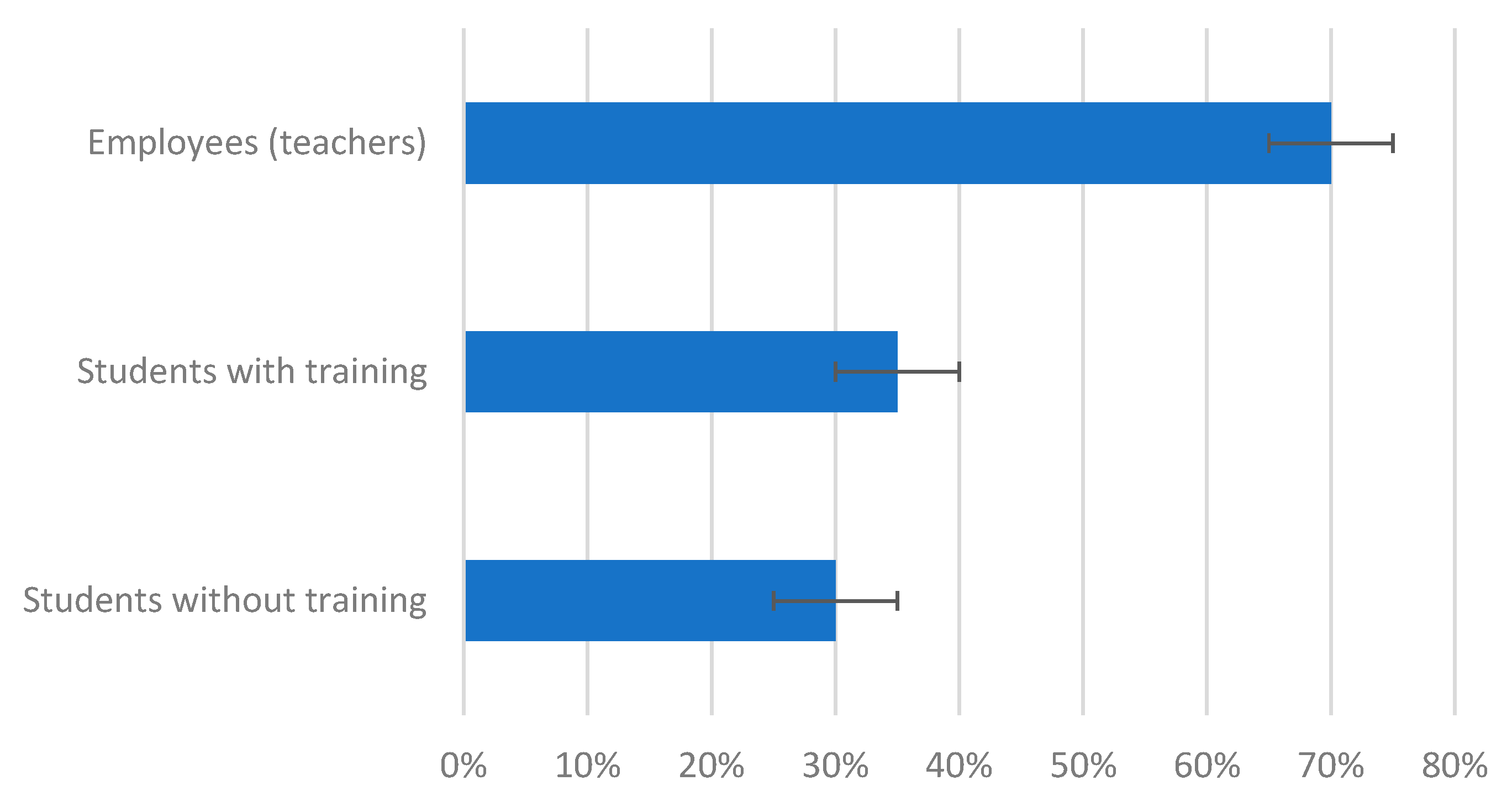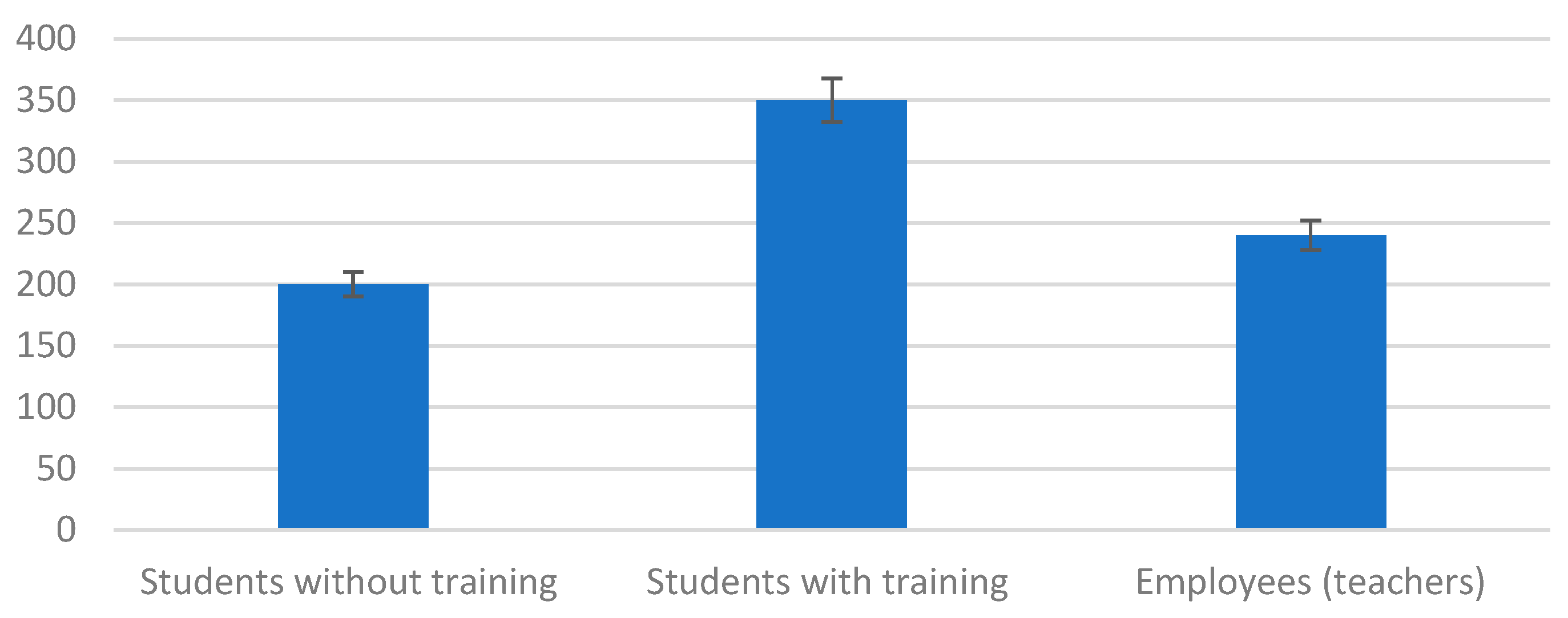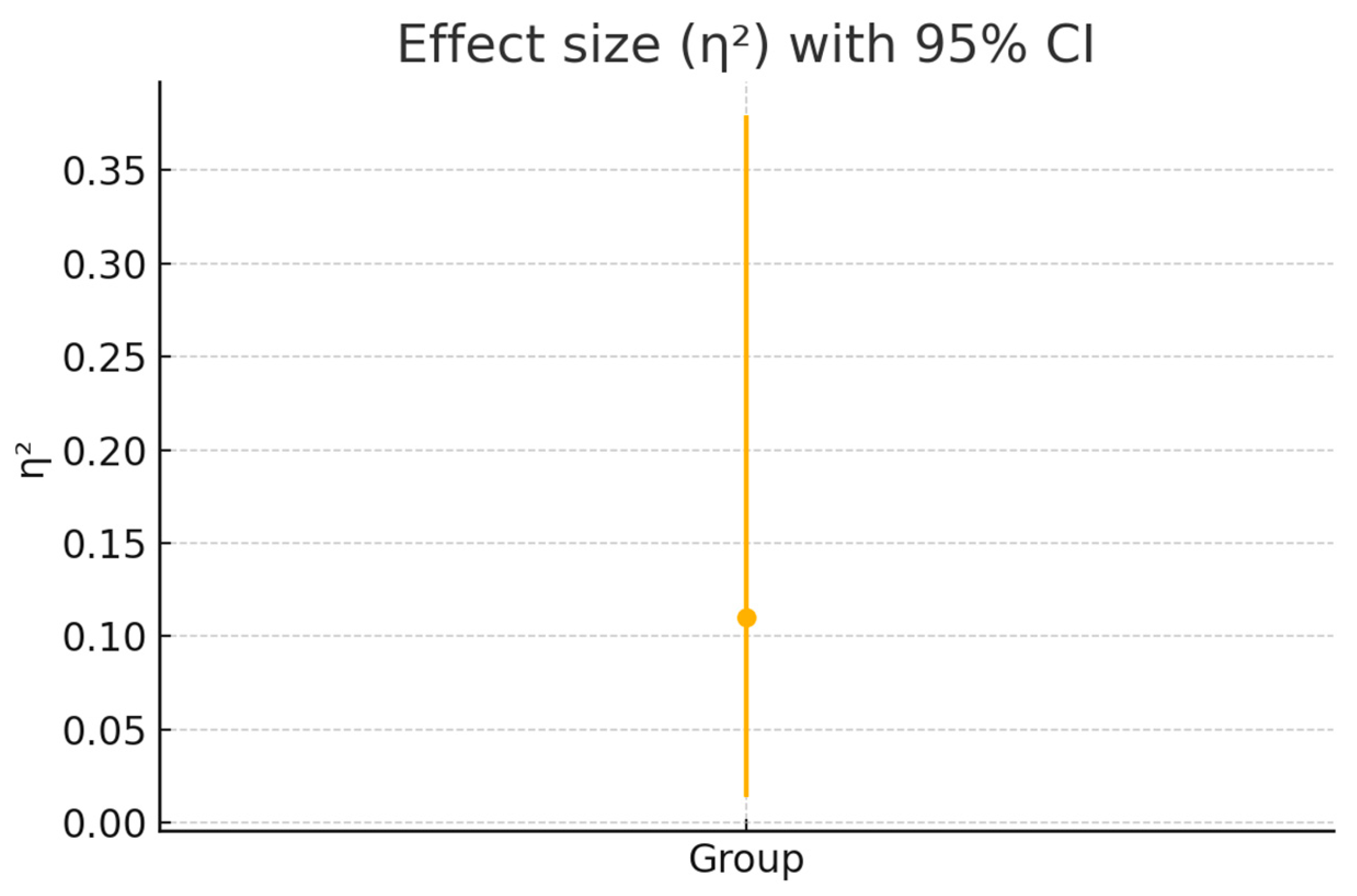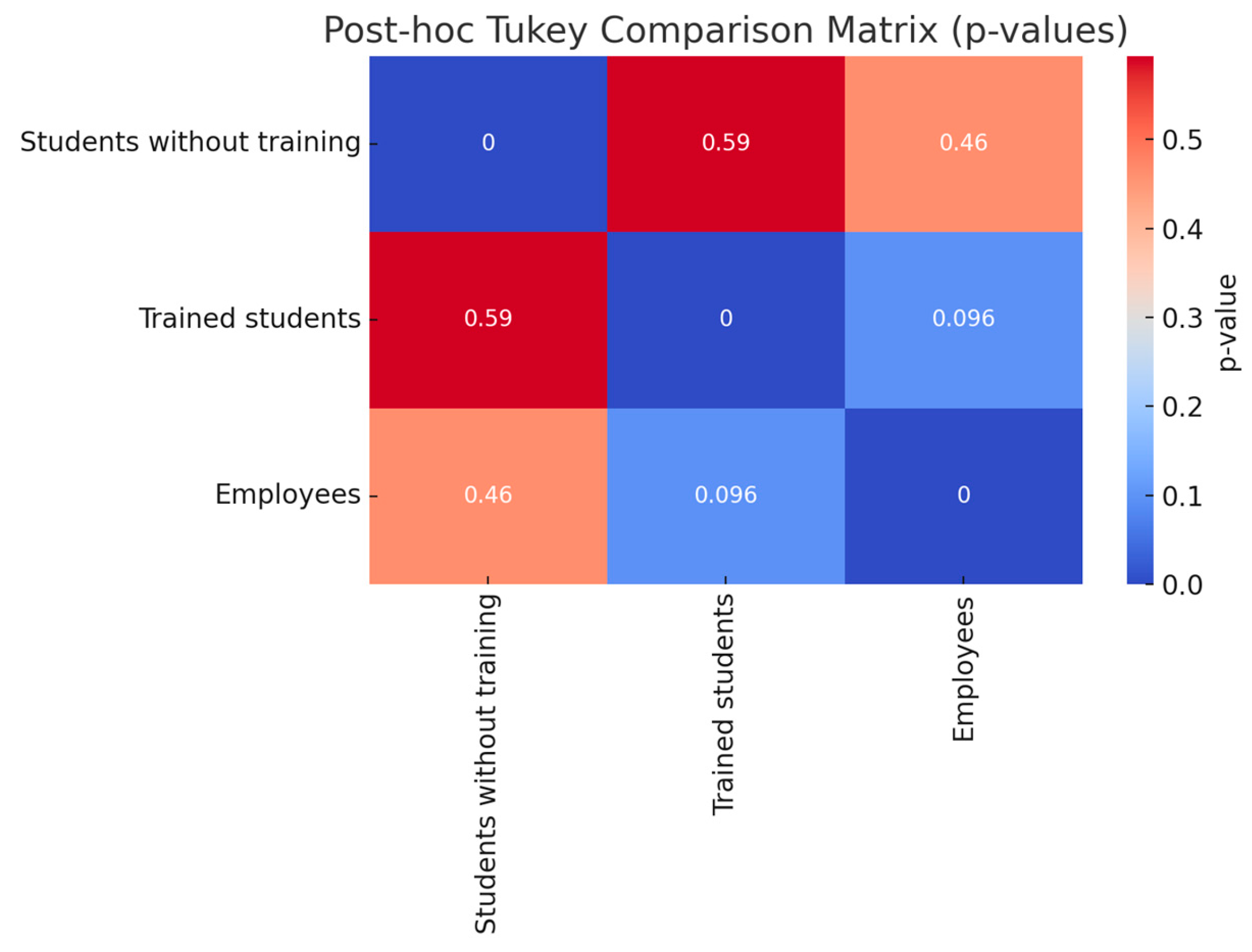2. Methods
A review of the literature on the proposed research topic and the use of eye tracking devices in identifying hazards and adverse events in the field of occupational health and safety facilitated the selection of equipment, definition of the research task, selection of participants, and then analysis of data and description of conclusions. In the literature, Dzeng et al. [
1] used the ViewPoint EyeTracker to study visual hazard search in four virtual construction sites. They found that the experience of construction workers shortened the time of hazard identification, but did not necessarily increase their accuracy. On the other hand, Hasanzadeh et al. [
2,
3,
4] conducted a study on construction workers and students using the SR Research EyeLink II, examining, among others, parameters such as time to first fixation, fixation time ratio, run count, and fixation count showed that hazard recognition skills affect visual search strategies. Similarly, examining eight construction workers using EyeTech VT3 and visual hazard search in 24 given images of site scenes, Jeelani et al. [
5,
6] suggested using eye-tracking systems to personalize hazard recognition training. Generally, due to the limited amount of specialized eye-tracking hardware and software, a review of the literature [
7,
8,
9,
10,
11,
12,
13,
14,
15,
16,
17,
18,
19,
20] showed the dominant use of Tobii solutions in research. The choice is facilitated by the universality of the available solution, ease of use of the software, and the availability of many indicators necessary to describe eye movement tracking. The studies were performed on both workers with construction experience [
1,
2,
3,
5,
7,
8,
20] and students [
3,
9,
11,
19]. These two groups were combined and compared in the studies by Dzeng et al. [
1]. In recent years, there has been a dynamic development of research on the use of eye-tracking technology in the context of identifying hazards and adverse events in the field of occupational health and safety, especially in the construction sector. The growing interest in this issue results from the need to better understand how employees perceive the work environment and what perceptual strategies they adopt in situations of potential danger. A literature review taking into account both classic positions and the latest studies published in 2023–2025 shows not only the development of eye-tracking technology, but also the diversity of research approaches, objectives, and application contexts. One of the most influential studies in this area is the work of Dzenga et al. [
1], who used the ViewPoint EyeTracker device to analyze visual search for hazards on four virtual construction sites. The conclusions from their research indicated that although professional experience shortens the time of hazard identification, it does not clearly translate into greater accuracy of their recognition. This indicated that the factor determining effectiveness may not only be experience, but also the quality of perception and cognitive skills. In turn, Hasanzadeh et al. [
3,
21,
22], using the SR Research EyeLink II system, focused on more detailed indicators of visual perception, such as time to first fixation, fixation time ratio, number of fixations, and runs. Their studies on groups of construction workers and students showed that differences in visual search strategies of work scenes are significantly related to the level of hazard recognition skills. Continuing this line of research, Jeelani et al. [
8,
23] used the EyeTech VT3 device to analyze visual search for hazards in static images of construction site situations. The results of their study, conducted among eight construction workers, were the basis for formulating recommendations for personalizing occupational safety training. It was suggested that training programs should be tailored to the individual perceptual patterns of participants, which may increase their effectiveness. In recent years, Tobii devices have become the dominant research tool in the field of eye tracking, which was confirmed by literature reviews. The popularity of these solutions is due to their universality, intuitive software, and a rich set of indicators necessary to describe perceptual processes. Work based on Tobii technology has been conducted on both professional groups and students, and differences between these populations were often analyzed to identify specific training needs and differences in cognitive competences. In turn, Sun, Q. et al. [
24] studied drivers’ trust in assistance systems in terms of situational awareness, which can be transferred to the context of autonomous construction machines. Zhou and Liao [
25] presented an approach using machine learning algorithms supported by EEG and eye-tracking data to classify threats in data-limited conditions, which indicates the potential of integrating neuro-perceptive technologies in safety analysis. An important direction of development is the integration of eye-tracking technology with IT systems used on construction sites. Wang et al. [
26] presented an approach combining domain knowledge with multimodal large language models (LLM) for the automation of safety inspections, which opens new perspectives for predictive systems in OSH.
In summary, the literature from 2023 to 2025 proves that eye-tracking technology has not only found a permanent place in research on occupational safety in construction, but is also increasingly integrated with other digital solutions—from BIM and VR, through augmented reality and AI systems, to large language models. At the same time, there is a growing awareness of the need to take into account the organizational, cultural, and psychophysical context of the users of these technologies. Such a broad and interdisciplinary approach provides a strong foundation for further research on the effective use of perceptual technologies in the design, training, and management of occupational safety.
Based on an extensive literature review, including both classic and recent studies from 2016 to 2025, it is possible to formulate a clear and logical research framework for the use of eye-tracking devices in identifying hazards and adverse events in the field of occupational health and safety in construction. Previous studies have shown the high effectiveness of eye-tracking technology in analyzing employees’ visual behavior in the context of hazard recognition. The works of Dzeng, Hasanzadeh, and Jeelani have shown that parameters such as time to first fixation, number of fixations, and their duration allow for assessing the effectiveness of hazard recognition, as well as differences in the approach to risk identification between people with professional experience, students, or less experienced workers. The research of Hasanzadeh and co-authors additionally indicated that the effectiveness of hazard recognition is influenced by personality traits, the level of situational awareness and environmental conditions such as fatigue, visual complexity of the scene, or working memory load. At the same time, many studies indicate the growing importance of integrating eye-tracking technology with other digital systems, such as augmented reality (AR), virtual reality (VR), building information modeling (BIM), or advanced artificial intelligence systems. For example, Wu et al. [
27] showed that eye-tracking combined with AR can be an effective tool for assessing situational awareness, while Chen and Sun presented examples of integrating spatial and visual data in simulated and real environments. Wang et al. proposed the use of large language models (LLM) to automate the analysis of safety data, which opens up new possibilities in the context of real-time visual data processing. Despite progress, there are still significant research gaps. There is a lack of a comprehensive model that would integrate eye-tracking data with decision support systems in dynamic, real-world construction conditions. In particular, the influence of experience, stress level, or cultural context on perceptual strategies has not been sufficiently studied. Previous studies have often been conducted in laboratory conditions or using static images, which limits their generalizability to real-world work environments. The need to automate the interpretation of visual data, personalize training, and adapt these approaches to the organizational conditions typical of small and medium-sized construction companies, which usually have limited resources and a lower level of safety culture, is still insufficiently considered.
In this context, it is appropriate to ask several key research questions: Which specific perceptual patterns correlate with high-risk recognition efficiency on the construction site? What is the significance of individual and organizational differences in risk perception? Is it possible to develop personalized training interventions that take into account these differences?
In light of the increasing availability of inexpensive technologies, it is becoming possible to consider the feasibility of implementations based on economical eye tracking solutions that could be adapted to the field conditions and infrastructural constraints of smaller construction companies. An example is lightweight, portable systems or mobile applications that enable visual activity recording with an acceptable level of accuracy, which can be used for educational, audit, or research purposes. Such an approach can facilitate the development of tools supporting OSH supervision even in contexts with limited budgets, thus increasing the availability of modern methods for assessing hazard perception. Based on the findings to date, it can also be assumed that people with greater professional experience are characterized by a shorter time to first fixation and more effective perceptual strategies, which additionally justifies the need to differentiate training content depending on the level of competence of participants.
Hypothetically, the integration of visual data with immersive training systems (AR/VR) can increase the effectiveness of hazard recognition. It can also be assumed that personalization of OHS training based on real cognitive data of users contributes to a better transfer of knowledge to behavior in the work environment. On this basis, a conceptual research model can be developed, in which the independent variables include the level of experience, complexity of the environment, visual interfaces, and psychosocial factors. The dependent variables include the effectiveness of hazard identification, reaction time, and the quality of decision-making.
In the context of integrating immersive technologies with eye tracking methods, it is worth referring to the research by Wu et al. [
27], who analyzed the visual behavior of users in augmented reality (AR) environments. Their study showed that eye-tracking parameters, such as fixation length, time to first fixation, and gaze density, can effectively reflect the level of understanding of training content and cognitive load. Integration of such indicators with adaptive AR/VR training environments can provide a basis for designing personalized OHS training that responds to the user’s real perceptual deficits. Incorporating the results of Wu et al.’s research into the proposed research model in the future will allow for the assessment of the feasibility and effectiveness of implementing these technologies in education and safety supervision in construction.
In addition, the intermediate variables are eye-tracking parameters, such as the length and number of fixations and visual scanning strategies. Such a model can be used to design quantitative and qualitative studies aimed at improving the effectiveness of training, audits, and safety management systems in the construction sector. The following conclusions from such research will have both theoretical and practical significance: on the one hand, they will expand knowledge about the cognitive mechanisms of risk perception, and on the other, they will contribute to the development of intelligent, user-adapted systems supporting work safety.
In addressing the identified research gap related to the real-time integration of eye-tracking data with decision-support systems, this work contributes by outlining a conceptual framework that includes both perceptual (eye-tracking) and contextual (environmental, psychosocial) variables. The proposed model allows for the testing of real-time relationships between visual attention patterns and safety-related decision outcomes, thereby providing a foundation for adaptive systems capable of live feedback and risk assessment. By integrating gaze metrics into immersive environments such as AR/VR and linking them to dynamic indicators of hazard recognition and decision-making performance, this study creates a pathway for developing systems that not only monitor workers’ attention but also adapt training content and alert systems in real time. This integration is particularly relevant for SMEs, where resource constraints necessitate highly targeted, efficient, and responsive OHS solutions.
Innovative approaches to resource allocation, monitoring the situational awareness of employees, and risk management in difficult environmental conditions have appeared in the literature. The research by Bachar, Urlainis, Wang, and Shohet [
28] focuses on the optimal allocation of safety resources in small and medium-sized construction enterprises (SMEs), demonstrating the need for more precise and targeted actions to maximize the effectiveness of OHS activities. These analyses are complemented by an earlier study by the team of Kim, Urlainis, Wang, and Shohet [
29], which analyzes the safety climate in SMEs, indicating significant cultural and organizational factors influencing the level of OHS compliance. In turn, Chae, Gupta, and Ham [
30] analyze the impact of various visual interfaces on the effectiveness of remote control of machines in difficult conditions of the construction site, which is of significant importance for teleoperation in the context of increasing operator safety. Augmented reality (AR) and eye tracking technology have also gained importance in the research of Wu et al. [
27], who use eye-tracking to measure workers’ situational awareness while using AR, opening up new possibilities for real-time risk assessment. In the context of monitoring the work environment and managing health risks in closed spaces, the results of Chen et al. [
31] are important because they proposed integrated BIM and VR systems for managing health risks in the urban metro environment. Similarly, Sun et al. [
32] present a technology which enables near-real 3D reconstruction of construction sites using surveillance cameras, which can significantly support risk assessment and planning of preventive actions. Significant innovations also include the use of wearable technologies and data analytics, as presented by Kim, Lee, and Jeon [
33] in a systematic review on wearable devices and their role in improving safety and health in construction. In terms of methodology, the study by Zeibak-Shini et al. [
34] introduce the analytical hierarchical process (AHP) method as a tool supporting decision-making regarding safety management and resource allocation. In parallel, tools using eye tracking to optimize the workspace are being developed. Zeng et al. [
35] used eye-tracking to design the signage system in underground chambers, indicating the possibilities of adapting the work environment to the perception of users. In the context of seismic safety, Raza et al. [
36] analyze both the technical aspects of building assessment and the social perception of risk by local communities, paying attention to the need to integrate the technical and educational dimensions. The collected studies from 2024 and 2025 show the dynamic development of methods supporting work safety in construction, with particular emphasis on small and medium-sized companies, as well as the implementation of immersive technologies and decision support systems. This trend indicates the growing importance of personalizing OHS solutions, adapting information technologies, and an interdisciplinary approach in research on safety in the work environment.
2.1. Research Site
A research station (
Figure 1) was created, equipped with a high-resolution, high-refresh multimedia projector adapted to visual perception tests, a device recording eye movements with high precision—Tobii Pro glasses, a research computer—a unit processing data from the eye tracker and displaying test stimuli. Additionally, the station was equipped with two GO-PRO cameras allowing for optional recording of facial reactions or the position of the examined person for better synchronization of results, and controlled lighting was used to minimize the impact of changes in light intensity on the test results.
Data analysis was performed using the Tobii Pro Lab version 1.217 analytical software, a tool for designing experiments and data analysis.
2.2. Research Procedure
Eye tracking research requires precise planning of the procedure to ensure high quality and reliability of the data obtained. A detailed description of the research procedure included the following stages:
Preparation of the research station in the form of hardware configuration and software preparation.
Obtaining informed consent from the subject to participate in the research experiment and preparation of the subject for the experiment, including instruction on the course of the study and the purpose of the experiment, as well as indication of limitations during the experiment, e.g., avoiding sudden head movements, frequent blinking, etc.
Calibration of the eye tracker, consisting in starting the nine-point calibration procedure and ensuring that the device correctly tracks the subject’s eye movements.
During calibration, it was ensured that the maximum visual angle deviation did not exceed 0.5°, which is the commonly accepted tolerance threshold for high-precision research using stationary eye-tracking systems. Calibration was repeated when the average deviation exceeded this value, to guarantee accurate and reliable gaze data. This threshold aligns with standards adopted in similar studies (e.g., Wu et al. [
27]; Hasanzadeh et al. [
7], allowing for the precise mapping of fixations to specific visual elements presented in the experimental materials.
After calibration, the experiment proceeded through the following steps:
Starting the experiment in the research software, consisting in presenting images and videos.
Completion of the study, including recording the results, synchronizing data from additional recording devices, and asking the subject for observations regarding the experiment.
Thanking the participant for taking part in the study.
The diagram in
Figure 2 reflects the recommended steps presented in publications such as Wu et al. [
27]; Zeibak-Shini et al. [
34]; and Hasanzadeh et al. [
3].
In future studies, it is recommended to report the reliability of the applied tools and procedures, such as test–retest reliability or inter-rater reliability where applicable. A more detailed descriptive statistical analysis of participants’ characteristics (e.g., visual acuity, prior exposure to construction sites, cognitive factors) should also be considered to contextualize the findings.
Additionally, the justification for the selected test duration and sample size should be explicitly discussed. In the case of pilot studies such as the one presented, small sample sizes may limit generalizability and statistical power; therefore, a power analysis should be conducted in future full-scale research to determine the minimum number of participants required to detect significant effects. This would improve the interpretability and reproducibility of results and facilitate comparisons with other studies in the domain of occupational safety and visual perception.
While conducting the tests according to the presented procedure, the key elements were precise calibration of the equipment and constant position of the subject ensuring correct registration of eye movements. In light of current research trends and taking into account the latest literature from 2023 to 2025, the research methodology using eye-tracking technology in the field of occupational safety in construction is based on the assumption that key information regarding hazard perception can be obtained by analyzing the visual behavior of participants in controlled experimental conditions. The presented approach used a laboratory environment in which stationary eye-tracking devices were used to precisely measure the direction and intensity of visual attention. This made it possible to conduct a reliable analysis that focused on identifying those elements of work scenarios—such as markings, barriers, dangerous zones, machines, or protective equipment—that attracted the attention of participants to the greatest extent, as well as those that were omitted. In accordance with the methodology adopted in the studies by Wu, Zeng, Sun, and Jeelani, the materials used in this study included both static photographic images and dynamic video materials presenting realistic situations on the construction site. These scenarios were prepared in such a way as to take into account typical and atypical work situations, including hazards resulting from working at heights, earthworks, operating construction machinery, lack of personal or collective protective equipment, and incorrect organization of the workspace. At the same time, materials were used presenting correct behaviors and technical solutions in accordance with applicable legal regulations and health and safety rules. The research group was selected in a way that allowed for a comparison of perceptual strategies of people with different levels of experience. The experiment involved students who had not undergone any training in the field of occupational safety, students who had undergone training, and academic staff and lecturers conducting classes in the field of construction engineering. Before starting the study, each participant expressed informed consent to participate in the experiment and to the processing of personal data, in accordance with applicable ethical standards. The eye-tracking equipment used (e.g., Tobii or EyeLink devices) enabled the measurement of indicators such as time to first fixation, total time of focusing the eyes on a given object, number of fixations, and eye movement trajectory. In addition, heat maps and scan sequences were generated to track and understand how participants searched the building environment visually. Analysis of this data allowed us to assess whether the markings and procedures used were sufficiently intuitive and whether participants’ gaze was directed to key safety-related elements. The collected data were subjected to quantitative analysis using statistical methods such as variance analysis, cross-group comparison tests, and regression models. In addition, in line with the latest solutions described in the works of Zhou and Liao, Wang and Sun, methods based on artificial intelligence and machine learning were incorporated into the visual data analysis, including classification and prediction algorithms, which allowed us to identify perceptual patterns typical of participants with a higher level of situational awareness. This methodology, in line with the latest research achievements, allows not only to assess the effectiveness of OHS training and procedures used on the construction site, but also to design new, personalized educational solutions. The data obtained can be used to optimize training materials, improve signage and work organization, and build predictive models supporting decisions in the field of safety management. Importantly, the integration of eye-tracking data with BIM, AR, and large language models allows these solutions to be implemented in more complex, dynamic work environments and real construction site conditions, which is currently one of the most important directions of research development in this field.
2.3. Eye Tracking Research Methodology
When conducting an eye-tracking study in the field of occupational health and safety in the analysis of safety on the construction site, stationary eye-tracking was used, which tracked the eye movements of the study participants in a controlled laboratory environment. This enabled the analysis of the perception of threats. Which visual elements (e.g., markings, barriers, warnings) attract the attention of the participants and how their eyesight is distributed in situations simulating construction conditions were checked. This enabled the identification of whether potentially dangerous areas are sufficiently noticeable. Another advantage of this approach was the possibility of assessing the perception of risk, consisting in understanding whether employees properly identify potential threats in the work environment, which is construction, and adapting training materials by introducing changes in their content and training structure to better meet the needs of users. This is related to the assessment of the effectiveness of training and procedures, which, as part of laboratory tests, can model emergency situations or present normal (correct) working conditions on the construction site. This allows checking how quickly and effectively the participants react to threats. Eye tracking data analysis allows us to assess whether the procedures and warning systems used are sufficiently intuitive and whether the workers’ eyesight is directed to critical elements. Studies were conducted (
Figure 3), using film and photo material, covering correct patterns of conducting construction works.
This study included a group of students who had not undergone standard training in the basics of occupational health and safety at construction sites, a group of students who had undergone standard training, and university employees and lecturers conducting classes in construction engineering.
In total, 15 people took part in this study, with the group of students consisting of 10 people and the group of employees consisting of 5 people. The group of students was divided into 2 teams. The first group consisted of inexperienced people, without training. The second group consisted of people who had been trained in the scope of occupational health and safety regulations on the construction site. The division of the groups was as follows: 1/3 students without training, 1/3 students after training, and 1/3 academic workers, lecturers.
The aim of the pilot study was to test methodological assumptions and to conduct a preliminary analysis of the differences in perception between groups of participants with different levels of knowledge and experience in the field of occupational safety. The authors express their intention to conduct a full study in real construction conditions, with the participation of a comparable group of participants, which would allow for obtaining more representative and practical results.
All participants, before starting the experiment, expressed informed consent to participate in the proposed research involving eye tracking and processing of data obtained on this basis. In addition, they expressed consent to the publication of their image.
2.4. Study Topic—Model Occupational Health and Safety Training
The training was covered with film and photo material covering correct patterns of conducting construction works in the context of occupational health and safety, identification of hazards and irregularities, discussion of deficiencies in equipping the employee with personal and collective protective equipment, as well as organization of the place of conducting construction works. The detailed subject of the training is earthworks and work at heights.
2.5. Exemplary Occupational Health and Safety Training
The model occupational health and safety training on construction sites for training participants, in accordance with the regulations in force in Poland, included in particular the following:
Labor Code (Journal of Laws 1974 No. 24 item 141, as amended).
Regulation of the Minister of Economy and Labor of 27 July 2004 on training in the field of occupational health and safety (Journal of Laws 2004 No. 180 item 1860, as amended).
Regulation of the Minister of Infrastructure of 6 February 2003 on occupational health and safety during construction works (Journal of Laws 2003 No. 47 item 401, as amended).
Regulation on general occupational health and safety regulations (Journal of Laws 2003 No. 169 item 1650, as amended).
The training structure included the following:
Introduction to occupational health and safety at construction sites in the form of a discussion of the basic legal acts regulating the principles of occupational health and safety in construction.
Presentation of the scope of employees’ and employer’s obligations in the field of safety and the legal and health consequences of non-compliance with occupational health and safety principles.
Presentations on the identification of hazards at construction sites showing risk factors related to working at heights, as well as a discussion of the hazards related to the operation of construction machinery and power tools, and also defining the risk resulting from improper storage of materials.
Discussion of the hazards related to the movement of vehicles at construction sites.
Presentations of personal and collective protective equipment, in particular the requirements for protective clothing and its proper use (helmets, gloves, safety footwear, reflective vests). The use of fall protection equipment (harnesses, lifelines, barriers) was also discussed, and when securing the work area in the form of system solutions (protective nets, handrails, marking of dangerous zones).
Another aspect of the model training was the discussion of the principles of safe work organization, including the following issues:
Correct use of scaffolding, ladders, and platforms.
Organization of transport and movement of materials on the construction site.
Work in excavation—protection against land subsidence.
Protection against electrical hazards on the construction site.
The training program was complemented by a discussion of the procedure in the event of an accident at a construction site, including first aid, accident reporting procedures, and the organization of evacuation in the event of a threat (e.g., fire, leakage of hazardous substances, etc.).
2.6. Additional Training in Earthworks and Work at Heights
Supplementary occupational health and safety (OSH) training for construction workers working at heights and in deep excavations is crucial to ensuring their safety. In the case of the study conducted, the participants of this training were a group of students who had already completed the model training described above. The topics of the supplementary training included for work in deep excavations:
Threats related to work in excavations in the form of landslides, flooding.
Securing excavations in the form of using casings, slopes, drainage systems.
Marking and fencing of the work area in the form of installing railings, warning signs, and lighting of the work area.
Emergency procedures, i.e., actions in the event of landslides or burying of an employee.
For work at height, the following was discussed:
Hazards related to working at heights such as falls, falling objects, loss of balance.
Collective protection measures in the form of railings, protective nets or work platforms.
Personal protection measures in the form of safety harnesses, safety lines, helmets, etc.
Principles of safe performance of work at heights.
The supplementary training also used multimedia teaching materials in the form of instructional films obtained from the National Labor Inspectorate
5. Research Discussion
The use of eye-tracking technology in research on occupational health and safety at construction sites has allowed us to obtain a number of valuable information on visual perception, cognitive processes, and the effectiveness of occupational health and safety training. The conducted research, using an eye-tracking station and an original research procedure, allowed for direct observation and measurement of participants’ attention patterns in controlled conditions, which enabled us to identify factors influencing the effectiveness of hazard recognition. The research results confirmed that the eye-tracking method is an excellent and highly reliable tool for testing and comparing the effectiveness of hazard recognition, both among trained and inexperienced people. The observed differences in fixation time (FT) and fixation sequence (FS) allowed us to distinguish different cognitive strategies used by participants depending on their experience and preparation. The longest fixation time was observed in students after the training, which indicates an intensive analysis of the material and an attempt to apply the acquired knowledge. In turn, the shortest fixation time, with the highest threat detection efficiency, was observed among university employees, which may suggest developed attention patterns and cognitive efficiency resulting from professional experience. Another important observation is the influence of the structure of training materials on the behavior of study participants. As shown in the analysis, participants’ eyesight naturally focused on human figures, objects filling a large part of the frame, and on intersecting visual elements, such as scaffolding or elements of building infrastructure. According to the results of studies (Wu et al. [
27]; Jeelani et al. [
6]; Zeng et al. [
35]), the way objects are arranged in the training material can significantly affect visual trajectories and thus the effectiveness of threat recognition. Our results confirm that better visual organization of presented scenes, both in photos and video materials, reduces cognitive load, increases the efficiency of visual analysis, and leads to higher efficiency of recognizing undesirable situations. At the same time, it should be noted that individual characteristics of participants, such as professional experience, previous participation in training, and the level of theoretical knowledge, have a significant impact on the way visual information is processed. This is confirmed by earlier findings of authors such as (Hasanzadeh, Dodd, and Esmaeili 2017–2019), who have repeatedly demonstrated that experience and knowledge of security procedures translate into faster and more accurate identification of potential threats. The analysis of visual paths and fixation sequences conducted in the presented study showed repeatability in the way the material was explored, which also correlates with earlier results regarding “expert patterns” in risk perception.
A more detailed analysis of gaze behavior revealed distinct visual patterns between experienced participants (university staff) and untrained students. In particular, experienced participants demonstrated compact fixation clusters concentrated on critical hazard zones, such as scaffold edges, unsecured excavation areas, electrical panels, or workers operating without PPE. Their scan paths showed goal-oriented saccades and shorter time to first fixation on high-risk objects, which indicates automaticity and efficient prioritization, likely developed through prolonged exposure to real construction environments and routine safety assessments.
In contrast, students without training often exhibited dispersed fixation patterns, with attention drawn to peripheral elements—such as non-relevant background structures, architectural details, or large static objects—rather than specific indicators of risk. In many cases, their visual paths followed less structured sequences, with increased dwell time on visually salient but irrelevant areas (e.g., a crane in the background rather than the missing railing in the foreground). Notably, trained students, although showing longer fixation durations overall, displayed a transitional pattern—their gaze was more frequently directed toward relevant hazard areas compared to untrained peers, but still less efficiently than experts.
In order to strengthen the theoretical foundation of this study and increase the scientific rigor of the conclusions, it is necessary to compare eye-tracking metrics with established constructs in cognitive psychology and educational psychology. Metrics such as fixation time, time to first fixation, or scan path regularity should be interpreted in light of recognized cognitive processes—such as selective attention, cognitive load theory, or dual-process models of reasoning. Such a framework would enable a more accurate explanation of the differences in hazard recognition performance among groups with different levels of experience and training. Moreover, linking visual behavior to cognitive constructs (e.g., working memory load or automatic vs. controlled processing) would improve the interpretability of results and allow the findings to be more effectively transferred to training design and human performance modeling.
